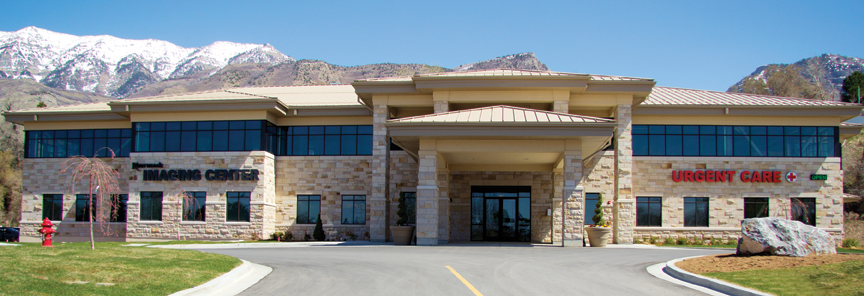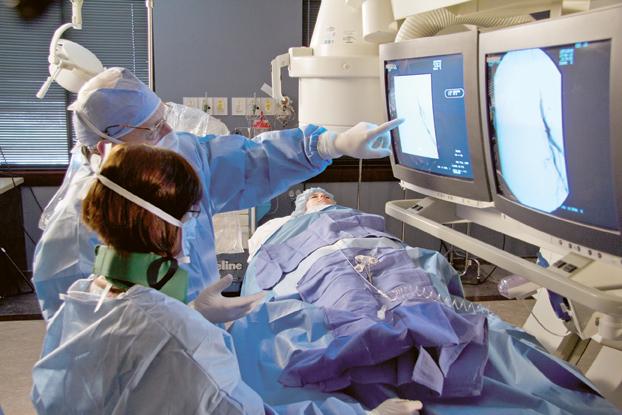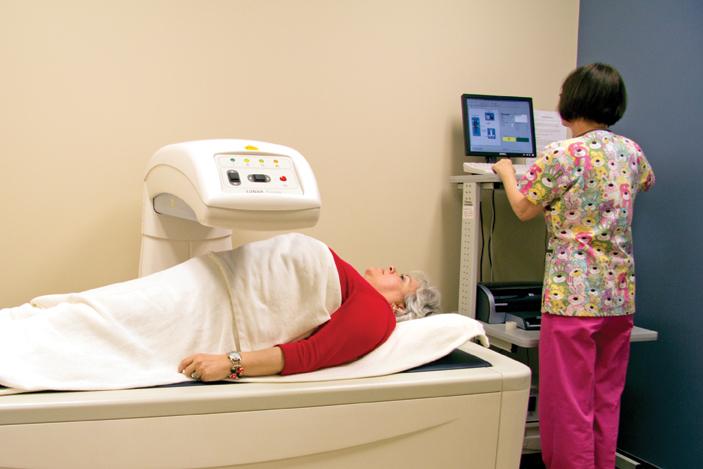
Riverwood Imaging Center in Provo, Utah, has been at its present facility since September 2011. It performs a variety of diagnostic procedures including angiography.
Riverwoods Imaging Center in Provo, Utah, built a strong imaging and interventional radiology program and made it profitable by creating a solid referral base and leveraging technology to make workflow more efficient. Opened in 2002 and located at its present facility since September 2011, the outpatient center offers a variety of diagnostic procedures, including magnetic resonance imaging (MRI), computed tomography (CT), ultrasound and conventional X-rays and fluoroscopy.
But it’s not enough to just have the latest equipment, says neuroradiologist Wendell Gibby, M.D., owner and president of Riverwoods. State-of-the-art imaging centers also need to have an efficient workflow system in place to keep everyone — from patients and referring doctors to insurance companies — happy and to keep the business afloat.
“It’s really more about what I consider an assembly line process,” says Gibby. “It’s everything, from when the doctor’s office calls in, to when images are performed and read and reports are generated. All of those things have to be done right in order to be competitive in today’s market.”
The center predominantly uses technology from GE and Siemens. Equipment includes a 1.5T MRI system, multislice CT scanner, ultrasound with cardiac capability, a digital mammography system and a digital angiography system. In addition, Riverwoods receives images from nine other facilities, reading them concurrently with its own studies. The center also performs interventional spinal procedures.
Streamlining Workflow
What has to set an imaging facility apart, says Gibby, is ensuring the process flows smoothly for all parties involved. And while keeping up with the technology is important, so is implementing a workflow management system.
“I don’t think that the quality of images has changed a lot in the last 10 years,” he says. “But with a struggling economy and growing pressure from third-party payers and the federal government to cut down on costs, imaging centers and other healthcare facilities alike have had to do more with less.”
To help accomplish this, Riverwoods uses the Novarad radiology information system (NovaRIS) to maintain a quick and efficient workflow. From scheduling to billing, the system helps the facility track each patient who comes through, freeing employees from dealing with the hassles of paperwork. This, in turn, decreases turnaround time for cases, something Gibby notes as very important to physicians and their patients.
“Most doctors don’t care if you have the greatest CT scanner on the planet. What they really want is good service,” he says. “They want a quick, accurate report.”
After scans are performed or received from one of the nine facilities, studies are read and dictated using Dragon voice recognition software that’s integrated with the Novarad system. Key images are pointed out on each MRI or CT scan, with arrows placed over the pathology to ensure understanding.
These key images are then automatically embedded into the report, so doctors need only to see a few items from the study, rather than a large set of 300 images. Gibby also uses an annotation system to record voice and cursor dictations, which can later be pulled up on another computer along with the images, guiding doctors to the study’s findings.
All reports are stored in a server, allowing technologists and nurses at Riverwoods to quickly access the reports and check them. Once reviewed, the cases are sent back to radiologists through the information system and signed, and the system automatically e-mails the finished reports to the referring physicians’ offices. This whole process reduces the burden on the front desk, says Gibby, and less time is spent waiting for radiologists’ signatures and for paper reports to be mailed out.
Patient Access to Images
Gibby also emphasizes the importance of having images readily accessible to patients, especially those whose images are sent from other facilities. With the increasing use of mobile devices such as iPads, physicians can use image viewer apps to easily bring images to their patients, wherever they are being treated. Riverwoods also provides patients with unique study passwords, giving them the ability to access their images online. These passwords are limited to their own study and have a specific timeframe. This accessibility adds convenience for patients who otherwise would have had to come to the center for copies of their images or a CD, Gibby explains.
In the outpatient imaging market, independent centers have to work more creatively to remain competitive. “More and more you see referring doctors buying their own machines, doing their own imaging,” he notes. “[Also] I think you’re seeing more competition from hospitals that initially were slow to get into the market.”
Building a Base of Referring Physicians and Satisfied Patients
The center focuses on maintaining a reliable network of referring physicians. The Riverwoods facility is located in a building whose other tenants include doctors’ offices, giving the center what Gibby calls a sort of “built-in referral base.” They utilize management tools in the RIS to analyze data and track referral trends, such as which doctors sent patients in the past year, and whose referrals are increasing or decreasing.
Outreach efforts have also grown. Reading images from nine other facilities in addition to its own may give Riverwoods more work to do, but it also contributes to revenues and provides more potential referrals, especially for interventional procedures. For example, an ultrasound sent from another facility could indicate a uterine fibroid in the patient. Since the center offers fibroid embolizations, this becomes an opportunity not only to report the finding to the patient, but also to inform her of the available procedure so the issue can be fixed right away.
“We have subscribed to a much more sophisticated model where it’s not just an MRI scanner or a CT scanner, but we have a full gamut of radiologic procedures, including advanced interventional procedures,” adds Gibby. “We try to provide a little more of a comprehensive program than most outpatient facilities.”
Patients have responded well to this strategy. In 2006, Riverwoods conducted a survey on patient satisfaction, asking patients to compare their experience at the imaging center to any previous experiences at a hospital. Results were “overwhelmingly supportive of the facility,” says Gibby.
A truly holistic experience can set imaging centers apart from the rest of the field. Offering to physicians and their patients a smooth imaging process — from scheduling to reporting to billing — along with state-of-the-art technology and advanced procedures helps facilities to remain competitive in a tough economy and, more importantly, to remain a reliable place for patients to receive diagnostic imaging.





 December 23, 2025
December 23, 2025 









